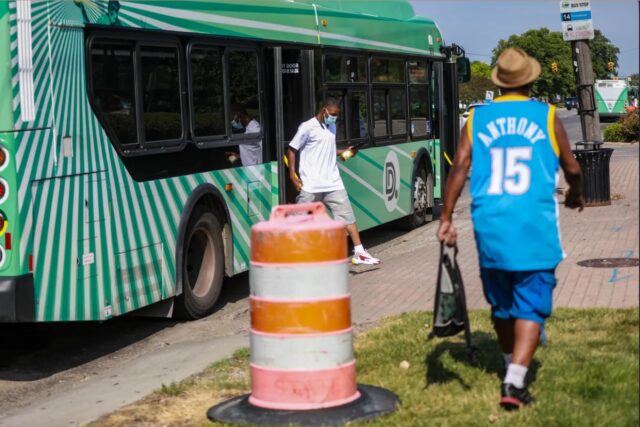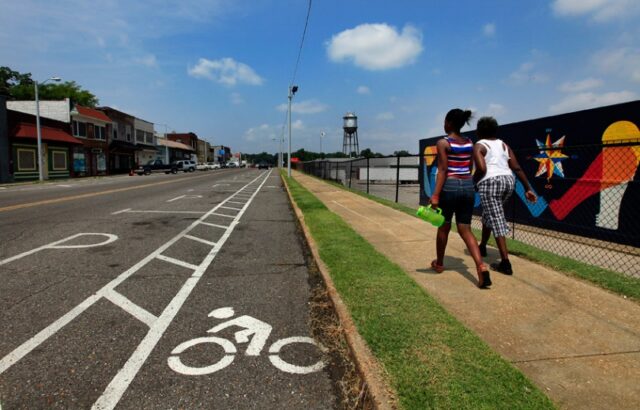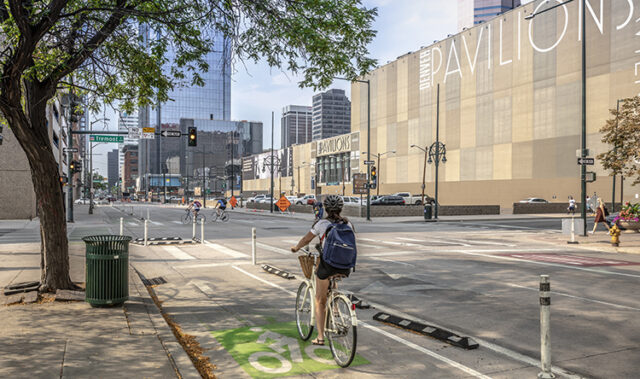Secretary Pete Buttigieg is scheduled to speak before a hearing of the House Transportation and Infrastructure Committee tomorrow. We are only a few months into the Biden Administration, and Secretary Pete has already been advancing a bold vision on safety, climate, and equity that is well aligned with the needs of US cities and brings necessary attention to core transportation issues and opportunity areas. Truly music to our mission-driven ears.
Thursday’s hearing is set to focus on the Biden Administration’s transportation priorities. With the far-reaching and ambitious thinking coming from the White House–and a number of key legislative agenda items queued up, including the expiration of the FAST Act–we expect to hear Secretary Pete cover a number of important topics.
NACTO is excited about any federal transportation agenda that puts people first and addresses the major challenges facing our country, from projects stretching coast to coast or across your neighborhood corner. But it’s the details we’ll be listening for from Secretary Pete, about the seemingly small-scale changes that would stand to have the biggest impact for American people and cities–with the lowest relative investment.
With that in mind, here are topics we’ll be listening for during Secretary Pete’s House T&I hearing:
Resetting the federal government’s relationship with transit
A reliable transit system provides affordable, efficient, and sustainable access to jobs, school, services, errands—the connections to opportunity that attract people to cities. Yet, fewer than 10 percent of Americans in urban areas are within walking distance of transit that runs at least once every 15 minutes. For America’s essential workers, riders, and communities, this isn’t good enough.
Reliable, convenient, affordable transit is the cornerstone of equitable climate action. In the wake of the pandemic, we should measure the success and quality of transit using metrics such as person throughput and frequency, rather than ridership alone. In addition, Congress can fundamentally improve lives and make access to high-quality transit a reality for millions of people in this country by:
- Ensuring equal funding for transit: Today, 80 percent of US federal transportation spending goes to highway projects, with only 20 percent left for transit. That means, for decades, the federal government has prioritized harmful road expansion over more beneficial investments in bus and rail systems. This has negatively impacted basic access to society for the households that cannot or do not have access to a personal vehicle, which in the US, are predominantly lower-income households of color. If we’re going to build out multimodal infrastructure at the scale necessary to reduce transportation emissions, provide viable alternatives to driving, and build a more just, connected society, it starts with fixing this funding disparity. NACTO supports Congress repealing the 80-20 split in favor of a more fair distribution of funding, as proposed in the Transit Parity Resolution.

Riders board the bus in Detroit (Kimberly P. Mitchell, Detroit Free Press)
- Funding transit operations: For decades, federal transit funding could only be spent on expanding systems and capital investments while transit agencies had to rely on local funding sources for everything else. This changed in 2020, when the CARES Act provided a much-needed infusion of federal aid to support transit operations. Sustained federal funding for operations and capital projects could form a new mobility backbone for an equitable and sustainable economic recovery. Funding more reliable transit will help this country make great strides towards breaking down structural inequalities. Poor transit service disproportionately affects Black American households; Black workers are four times more likely than white workers to use transit to access employment. Building back better—and more equitably—means funding better bus and transit service.
- Making it easier to access transit by biking, rolling, or walking: More reliable transit is only useful if people can get to it. Congress can strengthen connections to transit by expanding walking and biking networks through support for Complete Streets programs. Scaling up resources to help local communities implement Complete Streets projects will provide a major boost to local safety, connectivity, and access to better buses and trains.
- Fast-track a better MUTCD that truly supports safety, sustainability, and equity goals: While we don’t think it will come up during the hearing, USDOT and the Biden administration can take action on a foundation tool towards building a more multimodal United States: the Manual on Uniform Traffic Control Devices. The MUTCD sets standards for all traffic signals, signs, and markings on public roads in the US—and it is fundamentally flawed. It’s time for a rethink about whether the MUTCD is serving the goals it set out to; read more about our effort to encourage the federal government to reframe and rewrite it.
Investing dollars to meet people and needs where they are
It’s an unfortunate truth that many transportation decisions that affect cities are often made without any local input. Outmoded funding pathways mean that project scopes and outcomes for urban areas often do not reflect the needs and desires of local communities. Our hope is that the Biden administration, with a former mayor leading USDOT, will express renewed trust in America’s urban areas.
The smallest-scale projects, like filling critical sidewalk gaps, building missing pieces of a bike lane network, or improving an intersection where buses consistently get stuck in traffic, can often be the most impactful. These are low-cost, high-reward projects that serve city—and federal—goals, but are often delayed by preexisting norms around funding allocation, jurisdiction, and project review. With direct aid and increased decision-making power afforded to cities, local governments would be empowered to develop and implement projects that more directly benefit the residents they serve.
Putting safety and access at the core of every investment
Currently, the federal surface transportation program is structured to meet the goal of moving high volumes of cars at high speeds. This is incompatible with safety, point blank. We need the federal government to center safety, and approach it systematically, in order to realize the vision of more vibrant, connected, and just communities. Here are some ways they can start:

Bike, walking, and rolling infrastructure in Memphis (Livable Memphis)
- Set and enforce safety performance metrics that actually improve safety: There are states that have set annual safety goals for pedestrian and bike fatalities and serious injuries that are higher from year-to-year. We’ll repeat that: states have set performance goals that raise the number of serious injuries or deaths that should be permitted to happen on their streets. The federal government must use its authority to prohibit states from setting regressive safety performance targets and deny funding for plans that do not contain a strategy for improving road safety, especially in disproportionately impacted communities.
- Fund street safety improvements. An estimated 38,800 people were killed in motor vehicle crashes in the US in 2019, and 6,590 people were killed while walking—a five percent increase from 2018’s 30-year high. People of color, low income individuals, and older adults are killed and seriously injured in disproportionate numbers while walking on our streets. Funding Complete Streets initiatives on a nationwide scale, and giving cities more control over what is built on their streets, would go a long way towards addressing this. Fostering a safer experience on American streets is a multi-pronged effort, but we know that design informs behavior. Our streets should, and can, be safer and better.
- Downsize and retrofit dangerous vehicles. Large vehicles are dangerous for people walking and biking. We are calling on Congress to limit the use of increasingly large, heavy vehicles and improve driver visibility for the protection of all road users through two mechanisms: by creating a standards program for large vehicles and by directing NHTSA to adopt safety retrofit requirements on all trucks to increase protections for other road users.
Funding the ADA mandate
It is past time for the federal government to take a leadership role in helping cities meet requirements established in the Americans with Disabilities Act. Projects to make streets and transit accessible remain unfunded, leaving too many people isolated in their homes. To provide adequate support to help cities and transit agencies build fully accessible systems, Congress should create a federal capital funding program dedicated to accessibility improvements for both transit and roadways.
Meaningfully addressing climate change through transportation

A complete street in downtown Denver (HDR, Inc.)
Transportation is the largest share of greenhouse gas emissions in the US, fueling a climate crisis and exacerbating existing inequalities for low-income and communities of color. This is where the other pieces of the progressive transportation puzzle come together — readjusting the federal government’s focus from highways and road widenings to sidewalks, bike lanes, and transit will pay major dividends for the climate.
Infrastructure for transit, biking, and walking is the key to a sustainable future. Don’t get us wrong, electric vehicles will play a role in a lower-carbon future, but they’re still more energy-intensive and less impactful than simple bike, walk, and transit networks. Investing in policies and projects that make these modes safer, more reliable, and more connected are the key to shifting trips to truly sustainable modes.
Whether allocating more funding to transit and Complete Streets, mandating accountability in performance metrics, or extending the same project delivery flexibility afforded to states to local governments, there are the strategies that can support the implementation of multimodal networks and make the difference in encouraging more widespread adoption of climate-friendly transportation.
Despite its dry name, surface transportation reauthorization is deeply important. It determines how America will prioritize investments in transportation for half a decade, a window that could make or break the vision of a livable future. When the current bill expires in September 2021, we have a once-in-five-year opportunity to reframe the transportation conversation in the US.
Secretary Pete has already elevated topics of safety, equity, and climate, and the cornerstone role of transportation in realizing progress on all three fronts; and in many ways, this new Administration is moving forward with many of the items they can tackle in their first 100 days.
Yet Pete can’t do this alone. Congress is the key to passing a reauthorization bill that puts the needs of everyday Americans first. We’ll be listening at the hearing tomorrow to see what Secretary Pete is aiming to emphasize and champion in a new transportation bill, and we’ll equally be listening to how Congress responds. The stakes—and the opportunities for meaningful change—have never been higher.

A fall street in Minneapolis (Minneapolis DPW)